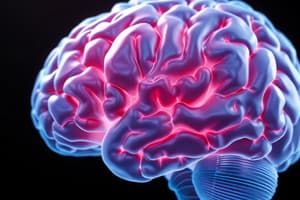Podcast
Questions and Answers
What is a primary function of the basal nuclei?
What is a primary function of the basal nuclei?
- Regulation of vision
- Control of movement (correct)
- Language comprehension
- Sensory processing
The basal nuclei are also referred to as the basal ganglia.
The basal nuclei are also referred to as the basal ganglia.
True (A)
Name one disease associated with degeneration of the basal nuclei.
Name one disease associated with degeneration of the basal nuclei.
Parkinson Disease
The substantia nigra provides _____ to the basal nuclei to modify movement.
The substantia nigra provides _____ to the basal nuclei to modify movement.
Match the following diseases with their associated effects on the basal nuclei:
Match the following diseases with their associated effects on the basal nuclei:
Which of the following structures is NOT part of the basal nuclei?
Which of the following structures is NOT part of the basal nuclei?
The globus pallidus sends its projections to the thalamus.
The globus pallidus sends its projections to the thalamus.
What is the nigrostriatal pathway responsible for?
What is the nigrostriatal pathway responsible for?
The _____ is the sixth structure of the basal nuclei located in the midbrain.
The _____ is the sixth structure of the basal nuclei located in the midbrain.
Which of the following is primarily associated with movement initiation and execution?
Which of the following is primarily associated with movement initiation and execution?
Flashcards
Basal Nuclei
Basal Nuclei
A group of structures involved in the control of movement as well as the regulation of mood and complex behaviors. It is located in the forebrain and midbrain.
Basal Ganglia
Basal Ganglia
A common name for the basal nuclei, however it is not correct as, "ganglion" is a cluster of nerve cells outside of the CNS.
Substantia Nigra
Substantia Nigra
Located in the midbrain, it provides dopamine to the basal nuclei for movement. Damage to this area leads to Parkinson's Disease.
Parkinson's Disease
Parkinson's Disease
Signup and view all the flashcards
Huntington's Disease
Huntington's Disease
Signup and view all the flashcards
Caudate Nucleus
Caudate Nucleus
Signup and view all the flashcards
Putamen
Putamen
Signup and view all the flashcards
Globus Pallidus
Globus Pallidus
Signup and view all the flashcards
Nigrostriatal Pathway
Nigrostriatal Pathway
Signup and view all the flashcards
Subthalamic Nucleus
Subthalamic Nucleus
Signup and view all the flashcards
Study Notes
Basal Nuclei (Basal Ganglia)
- Essential for movement control, mood regulation, and complex behaviors
- Older name: basal ganglia; however, this is inaccurate as basal nuclei are part of the CNS, unlike ganglia which are clusters outside the CNS.
- Six structures comprise the basal nuclei: four located in the forebrain (telencephalon), underneath the cortex and in front of the thalamus; and one in the midbrain, close to the other five.
- Receive dopamine from the substantia nigra of the midbrain.
- Dopamine deficiency (due to substantia nigra death) causes movement disorders (Parkinson's Disease).
- Parkinson's Disease may also be associated with mental disorders in approximately half of patients.
- Huntington's Disease, another degenerative basal nuclei disease, also causes mental disorders.
- Obsessive-compulsive disorder is linked to abnormalities in the caudate nucleus.
Basal Nuclei Motor Circuitry
- Extensive motor loops connect prefrontal cortex, premotor/ supplementary motor cortices (area 6), caudate, and putamen nuclei.
- Caudate and putamen output travels through the globus pallidus.
- Globus pallidus projects to ventral anterior and ventral lateral thalamus, which further project back to prefrontal cortex and area 6.
- Nigrostriatal pathway (substantia nigra to caudate and putamen) provides dopamine to regulate movement.
- Loss of these dopamine-producing cells causes Parkinson's Disease.
- Subthalamic nucleus, located beneath the thalamus, also modifies movement circuits within the basal nuclei.
- Damage to the subthalamic nucleus causes hemiballismus.
Basal Nuclei Function
- Primary function: initiating and executing movement.
- Role in action selection: choosing the appropriate movement from possible options, considering emotional aspects (reward/punishment).
- Asymmetry in caudate nucleus activity linked to obsessive-compulsive disorder.
- Parkinson's and Huntington's diseases present with both movement disorders and emotional disturbances.
Studying That Suits You
Use AI to generate personalized quizzes and flashcards to suit your learning preferences.




